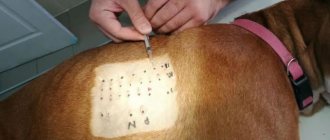If your dog is about to become a parent in the near future, then, of course, this is very exciting. You may fear for your pet's health and worry about the birth process. This is all normal.
In order not to get into trouble and to be fully prepared, it is better to thoroughly prepare for this process. Extra knowledge on the issue of giving birth to a dog will not hurt.
How to determine the approach in a week
Already a week before giving birth, the dog prepares physically. Here are the signs by which you can determine that in 5-7 days she will bring you puppies:
- At this time, the expectant mother begins to worry , look for a cozy corner, and fawn over the owner.
- During this period, it is necessary to pet your pet more often, to show with all your appearance that he has protection in your face.
- Some animals have a decrease in appetite , at this time you can pamper your pet with some kind of treat. Give more dairy products and broths.
Already from 57-58 days it is necessary to measure the dog’s body temperature twice a day. If the temperature data has decreased by 1-1.5 ºС, then this is a harbinger of an early birth. Within 24 hours the babies should be born. Immediately before birth, body temperature returns to normal.
Important! But if a low temperature or, on the contrary, an elevated one to 39 ºС lasts more than a day, then this is a reason to seek medical help. Perhaps the death of the fetus occurred and intoxication of the body began.
Stages of pregnancy
The gestation period in dogs lasts from 52 to 72 days from the moment the egg is fertilized. Physiologically, the countdown begins with the last ovulation, whelping occurs after 62-64 days. Depending on the behavior of the bitch and the development of the puppies, the following stages are distinguished:
- 1-20 days. The dog's behavior remains virtually unchanged. In rare cases, the animal becomes more lethargic, drowsy, and its appetite decreases. Possible toxicosis - vomiting, nausea after eating or at night.
- 20-45 day. This is a time of active growth and development of hearths. The bitch's belly is rounded. At 21 weeks, pregnancy can be confirmed using an ultrasound. From day 25, the concentration of the hormone relaxin in the blood increases. By day 40, the nipples enlarge and milk begins to be released.
- 46-62 days. The dog becomes less active and the size of the belly increases. When touched, you can feel the puppies pushing. During this time, it is not recommended to overload your pet with physical activity or long walks.
Signs of early pregnancy in representatives of small breeds appear on the 50th day, and in large breeds - on the 60th. At this stage, it is advisable to consult a veterinarian and undergo a control ultrasound. Problem breeds: toy terrier, chihuahua, Yorkshire terrier.
Photo: flickr.com
How can you tell if a bitch is giving birth today?
How does your pet behave before starting?
Experts distinguish three stages of the onset of labor:
- The first stage is preparatory, when the opening of the birth canal begins.
- The second stage is characterized by contractions.
- The third stage is the birth of puppies and the release of the placenta.
It is during the period of preparation for childbirth that the dog’s behavior changes not only physiologically, but also psychologically. It is expressed as follows:
- There is obvious restlessness in behavior, the bitch rushes around the house, begins to dig the floor or her bedding, and sometimes hides in a secluded place.
- It’s hard for her to stay in one place, she either lies down, gets up, or spins around.
- Some breeds become too affectionate during this period; they do not leave their owner’s side and look into his eyes in a special way.
- Some dogs start asking to go outside, take them out, but soon bring them back home .
- Some bitches lose their appetite, others ask for food, and others start vomiting. In this case, everything is individual.
Important! Changes in the animal's behavior require active participation on the part of the owner. He should show more attention and affection than usual. All these signs occur due to an increase in intra-abdominal pressure before childbirth. The first contractions of the uterus do not yet bring pain to the dog, but cause anxiety.
Physiological changes – temperature, water, etc.
Physiological changes as labor approaches include :
- Within 3-4 days, the bitch’s belly begins to “sag”.
- When looking at your pet from above, it seems that he has lost weight and you can even see “hungry” cavities on the sides.
- Although firstborns may not have these signs.
- Decrease in body temperature in dogs by 1-1.5 ºС 8-24 hours before birth. So, if a bitch’s temperature norm is 38-39 ºС, then before giving birth it drops to 37-37.5 ºС.
- And another sign of imminent delivery is a sharp subsidence of the puppies in the womb, which were previously actively pushing and moving.
A few hours before the birth of the cubs, the plug begins to come off, that is, a liquid whitish discharge appears .- During this period, the dog begins to tremble and chills, and the heartbeat and breathing increase.
All these physiological changes indicate that soon, in about a day, the puppies will be born .
The preparation stage can last from several hours to one day. If this time continues for more than 24 hours, and the dog does not go into labor, contact your veterinarian immediately.
Puppy box
Any clean, large box will suffice, but there are also many businesses that specialize in boxes for specific breeds.
Clinics advise placing the puppy box in a quiet, low-traffic area of your home. It should be easy for the mother dog to get in and out of, but difficult for the puppies. You can fill the box with newspaper for easy cleaning. Your dog needs to get used to his puppy box before the puppies arrive, otherwise he will give birth elsewhere.
Features of small breeds
Small breeds, such as dachshunds, Yorkshire terriers, chihuahuas and toy terriers, give birth in the same way as large breeds. But the period before childbirth may have distinctive features . The nervous system of small breeds is too delicate, so prenatal behavior will be more pronounced in them than in large dogs.
Yorkies, toy terriers, chihuahuas, and standard dachshunds bear their offspring for an average of 60-63 days; dwarf and rabbit dachshunds are pregnant for no more than 60 days.
Reference. The smaller the bitch, the fewer days she is pregnant.
Preparing and arranging a place for animals
The gestation period for puppies ranges from 59 to 63 days. You need to prepare for the upcoming birth in advance, several weeks before this important day. You need to agree with a doctor, because his presence is necessary, especially during the first birth or insufficient experience of the owner.
8-10 days before giving birth, it is necessary to arrange a place where the bitch will whelp. You need to prepare it in advance so that it gets used to the new place. The best option is to use a playpen or a fairly large box. This place should not be located on or on a cold floor.
You can give birth on a bed or sofa covered with oilcloth. It is necessary to avoid contact with carpets and palaces (it is generally better to remove them), because the upcoming process will be quite “dirty”.
It is necessary to arrange a place where the bitch and newborn puppies will be. A good option is to use a playpen or part of the room that needs to be arranged so that the puppies cannot get out. It is necessary to avoid hypothermia of the mother and offspring; for this purpose, you can use an infrared lamp or place a heating pad under the nest. But please note that you need to avoid overheating the dog (this can cause the onset of bleeding) and puppies (the best temperature for them during the first 10 days is +28, in the future it must be gradually reduced).
Primipara
Help
Many people are concerned about whether it is necessary to call a veterinarian for help if the dog is primiparous. Experts recommend doing this if the owner himself has never encountered the birth of a dog and does not know how to behave in this case. If the owner has encountered such a situation before and even participated in this process himself, then there is no need to worry. Although it is advisable to take the doctor’s number first.
Behavior
All the prenatal signs of a first-born dog will be much brighter than those animals that have already experienced giving birth to puppies. They rush around the house, can tear up the bedding, begin to whine loudly and even make sounds similar to a groan. 1-2 days before the start of the birth process, the animal may refuse food , but many dogs, on the contrary, are not averse to eating well. In general, the behavior of the firstborn is the same as that of all other pregnant dogs.
Primiparous dogs may not have as obvious external signs that she is about to give birth. If usually before the birth of puppies in animals, the belly drops and “hungry” pits form, then in firstborns these signs may not be noticeable.
Useful tips
- Feed your dog properly during pregnancy (expensive food for pregnant and lactating dogs or natural food with added vitamin supplements).
- Maintain your dog's hygiene during pregnancy and childbirth.
- Dead (?) puppy. The puppy may be born lifeless. Don't give up. Just gently and actively rub it with a clean towel and quickly remove the mucus from the nose and mouth with gauze, massage the chest, and rub it upside down. Gently open his mouth slightly. Do everything to make the puppy squeak.
- If your doe's milk supply is low, start giving her dairy products in large quantities.
- Puppy without a bladder. You need to quickly clear the airways by sucking out the mucus with your mouth.
- The umbilical cord should be cut immediately to prevent the formation of an umbilical hernia in the baby.
- It is necessary to change diapers after each puppy.
- It is important to place the firstborn with the bitch as soon as possible so that he begins to suck milk. This stimulates the birth of the remaining puppies.
- The puppy must defecate, starting the digestion mechanism. If this does not happen, massage his abdomen and anus with a piece of wet cotton wool.
- After each walk, treat the mother's nipples.
And the last piece of advice: never give your dog medications without the presence of a veterinarian to avoid the death of the dog.
Be as sensitive, attentive and collected as possible, and then you will have wonderful, healthy puppies. Your dog will reward you with devotion, love and endless trust.
Quick (quick) birth
Rapid or rapid labor in dogs is characterized by the birth of puppies - in 2-4 hours in multiparous females and in 4-6 hours in primiparous females. The danger of such births is that the waters break quickly, and the puppy has not yet been born . In this case, he may catch some kind of infection.
In addition, during rapid labor, the dog’s uterus contracts faster, and this condition can damage the fragile body of newborns, for example, injuring the cervical spine of puppies . Therefore, with a quick birth, you need to seek help from a professional.
Problems
If your dog is leaking dark green or black discharge from the vulva instead of breaking water, it is urgent. This complication occurs due to the premature separation of the placenta from the puppy. If she bleeds before her first puppy or between births, it's a literal warning. You need to get your dog and any puppies she delivers to a veterinary hospital as soon as possible. Other labor problems include more than two hours between births or severe pain from the mother dog.
Author of the article: Jane Meggitt . A lifelong animal lover, Jane Meggitt has been published in The Daily Puppy, The Nest Pets, Hoof Beats, Horse News and many other pet and horse related publications.
Carrying out the process at home
If you are new to this matter, it is better to enlist the help of a veterinarian or take your pet to the clinic. But it happens that there is no choice but to give birth to a dog yourself . Start preparing for this process in advance.
Remember that giving birth to puppies is a messy business, so have as many rags ready as possible . The blanket that you will lay under the bough will subsequently have to be thrown away, so there is no need to take a new one.
After this, a place for the birth is selected, as well as a box for the puppies . If the dog is large, then you can prepare a playpen; if it is not available, fence off more space and build something like a fence, since small children will actively try to get out from behind the fences. Make sure there is good heating . After this, prepare all the necessary tools for childbirth.
Attention! The day before the bitch whelps, wash the area of your pet's abdomen and genitals, and remove the hair in this area. Long wool is collected with an elastic band.
You should have the following medications on hand:
- Alcohol or vodka.
- Glucose ampoules 5%.
- Syntomycin emulsion 10%.
- Hydrogen peroxide.
- Traumeel and brilliant green.
Don’t forget to also prepare syringes, scissors, silk threads in case of tying the umbilical cord, and be sure to put notes in a visible place with all the phone numbers of veterinarians who will come to your aid at any time of the day.
If the dog itself cannot bite off the umbilical cord, for example, due to the anatomical features of the body, then the owner will have to do this. It is not recommended to use scissors for these purposes, as blood will flow. It's better to pull it and tear it off.
After the birth process begins and the babies come out, be sure to palpate the dog’s belly for any remaining babies. Also, all placenta should come out; if you doubt that the last placenta has come out, you need to contact a veterinarian.
By the way, the dog eats all the afterbirth . But if there are more than 2-3 of them, then do not allow her to eat the rest, otherwise digestive problems will begin. Don't forget to change soiled diapers.
Important! A dog that is exhausted after giving birth should not be disturbed or pulled; provide it with warmth and peace. In the first weeks, you do not need to often approach the mother with the puppies. Excessive attention will disturb the animal.
When should you take your dog in labor to the vet?
It is better to initially give birth in a hospital if the male was larger than the female or if the female weighs less than 4 kg and if the pregnancy was difficult.
When to go to the hospital or call the vet:
- The vaginal discharge smells unbearably.
- Long pauses between puppies coming out (more than an hour and a half); before the doctor arrives, massage the dog’s belly with light movements.
- Temperature above 40 degrees (this is a sign of death of the puppy).
- Restlessness of the pet after childbirth, impaired coordination, seizures.
- Loss of consciousness.
- The prenatal period lasts longer than a day.
- The birth of a stillborn puppy.
- The last afterbirth doesn't come out.
You will be much calmer if you invite a veterinarian into your home with the necessary set of medications.











